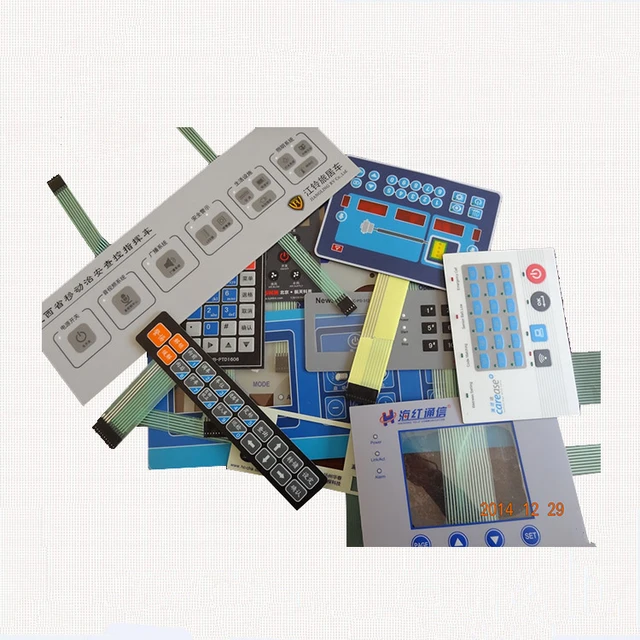How Membrane Switches Are Shaping the Future of Electronic Interfaces
How Membrane Switches Are Shaping the Future of Electronic Interfaces
Blog Article
Understanding Membrane Switches: The Secret to Dependable and long lasting Controls

What Are Membrane Buttons?
Membrane switches are an advanced service in the realm of interface technology, combining functionality and design effortlessly. These gadgets work as an interface between users and digital systems, incorporating a number of components right into a small layout. Commonly built from adaptable, slim layers of materials, membrane layer switches are developed to react to touch, allowing customers to communicate with machinery and digital devices efficiently.
The key aspects of a membrane button include a printed circuit layer, visuals overlay, and a spacer layer that protects against unintended activation. The graphic overlay can be customized to mirror brand name identity or individual preferences, improving aesthetics while guaranteeing usability. Membrane layer switches are generally made use of in various applications, including clinical gadgets, consumer electronics, and commercial tools, owing to their toughness and resistance to ecological elements such as dampness and dust.
Among the key advantages of membrane layer buttons is their ability to withstand wear and tear, making them suitable for high-traffic settings. Furthermore, they are lightweight and need marginal area, enabling innovative designs in item growth. Generally, membrane switches stand for a functional and efficient option for contemporary digital user interfaces, weding innovation with user-centric style principles.
Exactly How Membrane Changes Work
The procedure of membrane layer changes hinges on a simple yet effective mechanism that converts customer input into electronic signals. When a customer presses the switch, the leading layer flaws, allowing a conductive element in the circuit layer to make contact with an equivalent conductive pad on the bottom of the visuals overlay.
The style of membrane buttons can vary, but they commonly integrate domes or responsive aspects to offer responses to the user, improving the general experience - membrane switch. The products utilized in membrane switches, such as polyester or polycarbonate, add to their sturdiness and resistance to ecological factors, consisting of dampness and dust. Furthermore, his comment is here the printed circuits are usually enveloped, which protects them from deterioration over time.
Advantages of Membrane Switches

Furthermore, membrane layer buttons are understood for their sturdiness. Created from robust products, they are resistant to dirt, wetness, and physical wear, which considerably prolongs their life-span compared to standard mechanical switches. This durability makes them especially ideal for high-traffic atmospheres and applications calling for durability.
One more considerable benefit is the simplicity of cleaning and maintenance. The smooth surface area of membrane switches decreases dirt buildup and is frequently impervious to spills, making them suitable for settings that need frequent sanitization.
Additionally, membrane layer buttons use a structured account, causing a thinner design that can be incorporated into different gadgets without including bulk. This function not only boosts the visual appeal but also adds to a more ergonomic product style.
Applications of Membrane Switches
Flexible and user-friendly, membrane buttons locate applications across a vast my company array of markets, consisting of medical tools, consumer electronics, and commercial equipment. In the medical field, these switches are integral to devices such as diagnostic devices, individual monitoring systems, and infusion pumps, where dependability and simplicity of cleansing are crucial. Their capacity to endure rough environments and maintain functionality makes them perfect for such applications.

In customer electronics, membrane buttons are used in products like microwaves, cleaning machines, and push-button controls - membrane switch. Their sleek design permits for instinctive customer interfaces, boosting the general user experience while offering toughness and resistance to wear and tear
Commercial tools additionally gains from membrane layer switches, particularly in control panels for equipment and automation systems. These buttons offer protection against dirt and wetness, making sure consistent efficiency in challenging settings. Additionally, find more information their customizable attributes permit manufacturers to tailor them to particular operational needs, enhancing efficiency and capability.
Picking the Right Membrane Layer Change
When selecting a membrane button, it is necessary to think about various aspects that influence performance and viability for particular applications. The key factors to consider include environmental problems, responsive feedback, durability, and layout specifications.
First, analyze the operating atmosphere; switches revealed to moisture, chemicals, or extreme temperatures call for certain materials to ensure longevity and capability. Next, assess the need for responsive feedback. Relying on individual communication, some applications may gain from a responsive response to validate activation, while others may choose a non-tactile layout for visual factors.
Toughness is one more crucial element; membrane layer switches ought to be made to withstand frequent usage, impacts, and abrasion. Make certain the selected button can sustain the expected lifecycle, especially in high-usage circumstances.

Conclusion
In verdict, membrane layer switches over offer as crucial components in the style of long lasting and trusted control systems across various industries. The flexibility of membrane switches allows for customized remedies that satisfy specific operational demands, strengthening their value in modern-day technology.
Membrane switches represent a crucial element of modern user interface layout, mixing capability with resilience in different applications.Membrane layer buttons are an innovative service in the realm of user interface technology, integrating capability and style perfectly. Typically created from flexible, thin layers of products, membrane switches are created to react to touch, enabling customers to engage with equipment and electronic tools properly.
The design of membrane layer buttons can vary, however they typically integrate domes or tactile elements to provide comments to the individual, boosting the total experience.In conclusion, membrane layer switches over offer as necessary components in the design of sturdy and dependable control systems throughout various industries.
Report this page